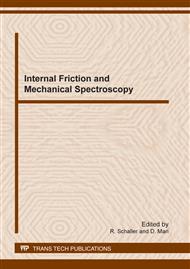p.277
p.283
p.289
p.295
p.301
p.307
p.313
p.319
p.325
Simulation of Mechanical Response in Nanoparticles
Abstract:
Morphology and mechanical resonse of copper nanoparticles with defects have been simulated by means of molecular dynamics simulation. The embedded atom method potential for copper was used to express the interaction of atoms. Four types of model samples were prepared and about 37,000 atoms were contained in each sample. Two of them are cubic shape with {100} surfaces, in which vacancies or interstitials are introduced. The other two samples are once melted and solidified particles with nearly spherical surfaces. The atomic structure is controlled by cooling rate, and crystalline and amorphous structures are realized. Shear and tetragonal strains are applied to the samples and stress-strain relations for the samples are derived. Mechanical damping and internal friction were evaluated from the free decaying oscillations by releasing static strains.
Info:
Periodical:
Pages:
301-306
Citation:
Online since:
January 2012
Authors:
Keywords:
Price:
Сopyright:
© 2012 Trans Tech Publications Ltd. All Rights Reserved
Share:
Citation:


